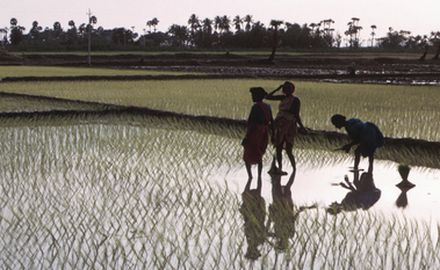Indian monsoon: novel approach allows early forecasting

Indian rice farmers depend on monsoon rainfall. Photo: Hemera/thinkstock
“We can predict the beginning of the Indian monsoon two weeks earlier, and the end of it even six weeks earlier than before – which is quite a breakthrough, given that for the farmers every day counts,” says Veronika Stolbova from the Potsdam Institute for Climate Impact Research (PIK) and the University of Zurich, the lead-author of the study to be published in the Geophysical Research Letters. “We found that in North Pakistan and the Eastern Ghats, a mountain range close to the Indian Ocean, changes of temperatures and humidity mark a critical transition to monsoon,” explains Stolbova. Conventionally, the focus has been on the Kerala region on the southern tip of India.
Rainfall timing is key for growing rice, but also for generating hydro power
Information about monsoon timing is key for Indian farmers to determine when to carry out the sowing. Crops like rice, soybean and cotton are normally grown during the June to September monsoon rainy season. Even a slight deviation of the monsoon can lead to droughts or floods, causing damages. Also, the length of the monsoon is relevant for planning hydro power generation since the rains are necessary to fill the dams and reservoirs.
The scientists tested their method with historical monsoon data. It gives correct predictions for onset in more than 70 percent and for withdrawal in more than 80 percent of the considered years. The main advantage of the proposed approach is that it allows to improve the time horizon of the prediction compared to the methods currently used in India. In addition, the new scheme notably improves the forecasting of monsoon timing during years affected by the global weather phenomenon El Niño – Southern Oscillation (ENSO), particularly in its La Niña phase. This phenomenon significantly alters monsoon timing and decreases the prediction accuracy in existing methods.
Network analysis: “The climate system is just like Facebook”
“We see the climate system as a network, just like the social networks so many people are using in their everyday life,” says co-author Jürgen Kurths, head of PIK’s research domain Transdisciplinary Concepts & Methods. “On Facebook or Twitter, you can follow how news is spreading, one posting leading to many others. In the climate system, not people but geographical regions are communicating – admittedly in a quite complex way.” Like Facebook postings or tweets that get shared over and over again, temperature and humidity get transported from one place to another by atmospheric flows, such as winds.
Using the network analysis of complex non-linear systems, an advanced mathematical approach, for monsoon forecasting is unprecedented – yet the approach shows good results. The major innovation, the authors say, is to combine the network analysis with the subtle statistical analyses of the early warning signals for the monsoon onset and withdrawal. “These precursor phenomena are often buried by huge piles of weather data and hence get overlooked,” says Elena Surovyatkina of the Russian Academy of Sciences’ Space Research Institute, currently a PIK guest scientist. “We discovered how to use precursors in a new way – to find regions where critical conditions for an occurence of the Indian monsoon originate.” This has been achieved in cooperation with co-author Bodo Bookhagen from the University of Potsdam. In the future, this method can also help to unravel mysteries of other climate phenomena.
Climate change affects rainfall, making accurate predictions more important
Global warming due to mankind’s greenhouse-gas emissions from burning fossil fuels already affects the Indian monsoon and – if unabated – is expected to do even more so in the future. “We’re seeing this in our data, and other research also points in this direction,” says project-lead Jürgen Kurths. “The timing of Indian summer monsoon, on which the livelihoods of many million people depend, is likely becoming more erratic. This makes early and accurate forecasting ever more crucial.”
Article: Stolbova, V., E. Surovyatkina, B. Bookhagen, and J. Kurths (2016): Tipping elements of the Indian monsoon: Prediction of onset and withdrawal. Geophys. Res. Lett., 43, 1–9 [doi:10.1002/2016GL068392]
Weblink to the article: http://onlinelibrary.wiley.com/doi/10.1002/2016GL068392/full
For further information please contact:
PIK press office
Phone: +49 331 288 25 07
E-Mail: press@pik-potsdam.de
Twitter: @PIK_Climate
www.pik-potsdam.de
Media Contact
All latest news from the category: Earth Sciences
Earth Sciences (also referred to as Geosciences), which deals with basic issues surrounding our planet, plays a vital role in the area of energy and raw materials supply.
Earth Sciences comprises subjects such as geology, geography, geological informatics, paleontology, mineralogy, petrography, crystallography, geophysics, geodesy, glaciology, cartography, photogrammetry, meteorology and seismology, early-warning systems, earthquake research and polar research.
Newest articles

Pinpointing hydrogen isotopes in titanium hydride nanofilms
Although it is the smallest and lightest atom, hydrogen can have a big impact by infiltrating other materials and affecting their properties, such as superconductivity and metal-insulator-transitions. Now, researchers from…

A new way of entangling light and sound
For a wide variety of emerging quantum technologies, such as secure quantum communications and quantum computing, quantum entanglement is a prerequisite. Scientists at the Max-Planck-Institute for the Science of Light…

Telescope for NASA’s Roman Mission complete, delivered to Goddard
NASA’s Nancy Grace Roman Space Telescope is one giant step closer to unlocking the mysteries of the universe. The mission has now received its final major delivery: the Optical Telescope…



